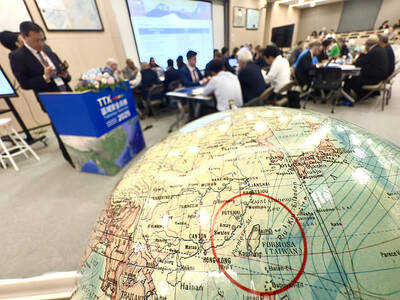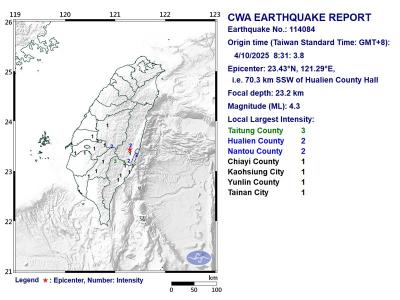The Taiwanese Navy is purchasing hundreds of specialized sonobuoys from the US to augment its anti-submarine warfare capabilities, a US Department of Defense notice said on Friday.
Under the Foreign Military Sale, Taiwan will acquire 440 AN/SSQ-53F sonobuoys for US$335,000, with work scheduled for completion by January 2014 (as part of the same deal, the US Navy is purchasing 49,900).
Sonobuoys, also known as “listening sticks,” are used to detect and identify moving underwater objects.
The AN/SSQ-53F directional frequency and ranging (DIFAR) sonobuoy — the latest-generation passive sonobuoy used by the US Navy — is dropped from fixed-wing aircraft or helicopters and uses four hydrophones that operate at depths of 27m, 60m, 120m and 300m, as well as digital sound processors, to listen for enemy submarines.
Unlike “active” sonobuoys, which locate objects by bouncing a “ping” off a vessel, passive types gather emissions created by moving underwater objects.
Aircraft can drop a pattern of sonobuoys, which relay information back to the aircraft by radio link to determine the exact location of enemy submarines.
In Taiwan’s case, the sonobuoys are likely to be used on the 12 refurbished P-3C “Orion” marine patrol aircraft it has purchased from the US, which are expected to start being delivered this year.
Sonobuoys are designed to determine the direction from which a signal originates. Through triangulation, a pattern of listening sticks can determine a target’s range, bearing and location.
The operational life of a sonobuoy can be set from 30 minutes to eight hours, whereupon the device automatically scuttles itself.
In November last year, Taiwan also ordered 44 AN/SSQ-36s — ocean thermometers used to establish what is known as the “temperature geography.” Water temperature, which affects sonar propagation and acoustic range prediction, tends to vary depending on depth.
Establishing temperatures before launching sonobuoys, such as the AN/SSQ-53F, can therefore ensure optimal performance.
China has at least 65 submarines in its navy’s undersea forces, with four nuclear-powered ballistic missile submarines (SSBN), at least five nuclear-powered attack submarines and 56 conventional submarines.
The Type 094 SSBN, which is equipped with the JL-2 nuclear missile and was launched in 2004, has been of particular concern to the international community.

DEFENSE: The National Security Bureau promised to expand communication and intelligence cooperation with global partners and enhance its strategic analytical skills China has not only increased military exercises and “gray zone” tactics against Taiwan this year, but also continues to recruit military personnel for espionage, the National Security Bureau (NSB) said yesterday in a report to the Legislative Yuan. The bureau submitted the report ahead of NSB Director-General Tsai Ming-yen’s (蔡明彥) appearance before the Foreign and National Defense Committee today. Last year, the Chinese People’s Liberation Army (PLA) conducted “Joint Sword-2024A and B” military exercises targeting Taiwan and carried out 40 combat readiness patrols, the bureau said. In addition, Chinese military aircraft entered Taiwan’s airspace 3,070 times last year, up about

A magnitude 4.3 earthquake struck eastern Taiwan's Hualien County at 8:31am today, according to the Central Weather Administration (CWA). The epicenter of the temblor was located in Hualien County, about 70.3 kilometers south southwest of Hualien County Hall, at a depth of 23.2km, according to the administration. There were no immediate reports of damage resulting from the quake. The earthquake's intensity, which gauges the actual effect of a temblor, was highest in Taitung County, where it measured 3 on Taiwan's 7-tier intensity scale. The quake also measured an intensity of 2 in Hualien and Nantou counties, the CWA said.

The Overseas Community Affairs Council (OCAC) yesterday announced a fundraising campaign to support survivors of the magnitude 7.7 earthquake that struck Myanmar on March 28, with two prayer events scheduled in Taipei and Taichung later this week. “While initial rescue operations have concluded [in Myanmar], many survivors are now facing increasingly difficult living conditions,” OCAC Minister Hsu Chia-ching (徐佳青) told a news conference in Taipei. The fundraising campaign, which runs through May 31, is focused on supporting the reconstruction of damaged overseas compatriot schools, assisting students from Myanmar in Taiwan, and providing essential items, such as drinking water, food and medical supplies,

New Party Deputy Secretary-General You Chih-pin (游智彬) this morning went to the National Immigration Agency (NIA) to “turn himself in” after being notified that he had failed to provide proof of having renounced his Chinese household registration. He was one of more than 10,000 naturalized Taiwanese citizens from China who were informed by the NIA that their Taiwanese citizenship might be revoked if they fail to provide the proof in three months, people familiar with the matter said. You said he has proof that he had renounced his Chinese household registration and demanded the NIA provide proof that he still had Chinese